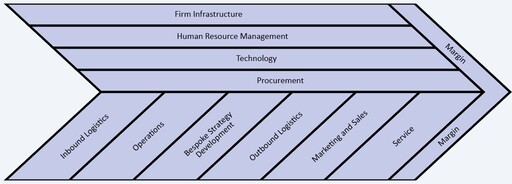 What is Value Chain Analysis
What is Value Chain Analysis
Value Chain Analysis helps you to identify and analyse the processes by which an organisation creates value.
The Value Chain separates processes into:
- Core Processes: the main processes by which the organisation adds value to inputs in order to create outputs and ultimately the products and services it provides.
- Support Processes: additional processes which are necessary for the efficient and effective operation of the organisation.
Core Processes from the Value Chain Analysis also appear as Key Activities on the Business Model Canvas. Support Processes do not.
How to use the value chain
When you first use the Value Chain, StratNavApp.com will create a default set of core and supporting processes.
You can then edit, delete or add processes to get to the specific value chain for the organisation in question. You can also drag and drop processes to sort them.
Once you've described the value chain you can click on any process to add more detail, analysis and insights. See Working with Processes.
What to use value chain analysis for
You can use the value chain for a number of purposes:
- Descriptive: the value chain provides a framework for developing a common language and holistic description for talking about the organisation. This is useful for overcoming organisational biases and siloed thinking.
- Prescriptive: the value chain can be used as part of the process of developing a target operating model for an organisation, understanding any gaps between the current operating model and target operating model, and developing plans (initiatives) for closing those gaps.
- Analytical: the value chain provides a framework for identifying strengths and weaknesses (and, to a lesser extent, threats and opportunities) that are more grounded in the reality of the organisation. This is useful for avoiding the more abstract insights that many organisations fall back on and which mitigate against strategic thought and action. StratNavApp.com will ensure that any strategic insights generated in this way appear in the appropriate models in the Analysis -> Insights section of the tool.
The Value Chain is one of the more established strategy models, having been introduced by Michael Porter in his influential book "Competitive Advantage".
Where to find the Value Chain
To find your Value Chain:
- Sign in to StratNavApp.com.
- Select the project you want to work with.
- Click on "Analysis" on the main menu.
- Click on "Business Model" on the drop-down menu that opens up.
- Select "Value Chain" on the model selector on the page that follows.
What to do when you've completed your Value Chain
Once you've completed your Value Chain you can also:
- Download it as an image to paste into another document, presentation or email by clicking the "download image" button
- see to the right and Downloading Images from StratNavApp.com
- Print it to paper or a PDF.
- Include it in a strategy plan or report - see Generating Strategy Reports from StratNavApp.com
- Use it as the basis for identifying the strengths and weaknesses on your SWOT analysis:
- Double-click on a process on the Value Chain to open up the detail page behind.
- Click "Add insights pertinent to this process" in the "Do Next section"
- Type an insight (a strength or a weakness) and press Enter.
In this way you SWOT is linked to and grounded in your Value Chain analysis.
